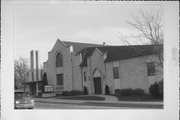Property Record
BADGER ST
Architecture and History Inventory
| Historic Name: | Trinity Lutheran Church |
|---|---|
| Other Name: | Trinity Lutheran Church |
| Contributing: | |
| Reference Number: | 116833 |
| Location (Address): | BADGER ST |
|---|---|
| County: | Waupaca |
| City: | Waupaca |
| Township/Village: | |
| Unincorporated Community: | |
| Town: | |
| Range: | |
| Direction: | |
| Section: | |
| Quarter Section: | |
| Quarter/Quarter Section: |
| Year Built: | 1949 |
|---|---|
| Additions: | |
| Survey Date: | 1998 |
| Historic Use: | house of worship |
| Architectural Style: | Late Gothic Revival |
| Structural System: | |
| Wall Material: | Stone Veneer |
| Architect: | Auler, Jensen & Brown |
| Other Buildings On Site: | |
| Demolished?: | No |
| Demolished Date: |
| National/State Register Listing Name: | Not listed |
|---|---|
| National Register Listing Date: | |
| State Register Listing Date: |
| Additional Information: | The Trinity Lutheran Church is a large, rambling building constructed in the late Gothic Revival style. The main block has a gable roof with raised parapet and the west ell has a hip roof. The east ell has a flat roof. The building is covered with stone veneer sometimes referred to as "Lannon Stone." The entrance and main elevation of the main block are decorated with shallow pilasters. Most of the openings are rectangular, but gothic arches decorate the main block stained glass window and the main entrance to the west ell. The bell tower is in the east ell and consists of two rectangular spires flanked by piers. A cross sits in the middle of the spires. Although the style had long ago died out in residential construction, Gothic Revival details were still being used on churches during this period. However, the use of the style was becoming streamlined and less detailed, as seen by the lack of elaborate gothic details on this building. The church was designed by noted Wisconsin architects, Auler, Jensen and Brown, who were active in the mid-twentieth century, designing institutional buildings. The church building is also historically significant because it represents the growth and development of the Danish Luthern church in Waupaca. Waupaca's large Danish community developed several ethnic churches, the most important being two Danish Lutheran churches, which merged just before this building was erected. The Trinity Lutheran Church is the culmination of the growth of this congregation and it remains an important church in the community today. |
|---|---|
| Bibliographic References: | Freiburger, Rosemary and John Holzman. Our Heritage. Waupaca, WI: Waupaca County Post, 1976, 115-117. Waupaca Post, 8 November 1945, p. 1. |
| Wisconsin Architecture and History Inventory, State Historic Preservation Office, Wisconsin Historical Society, Madison, Wisconsin |

